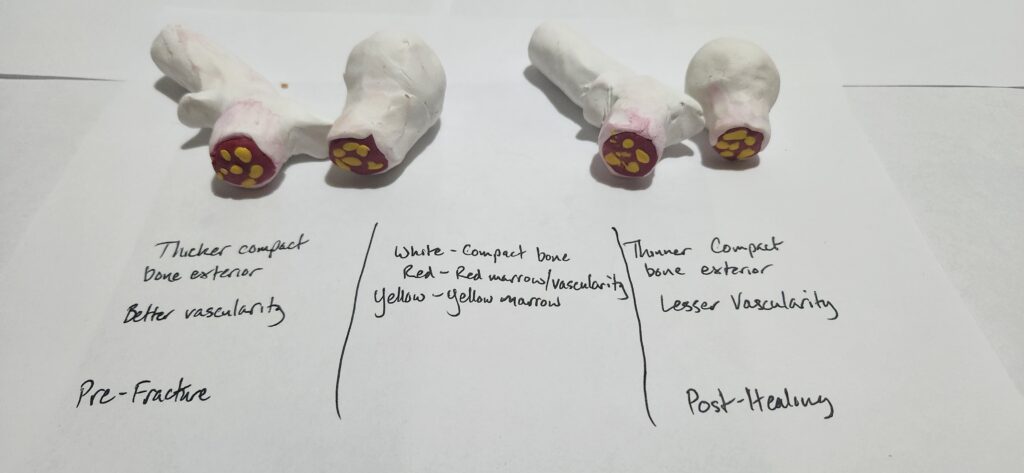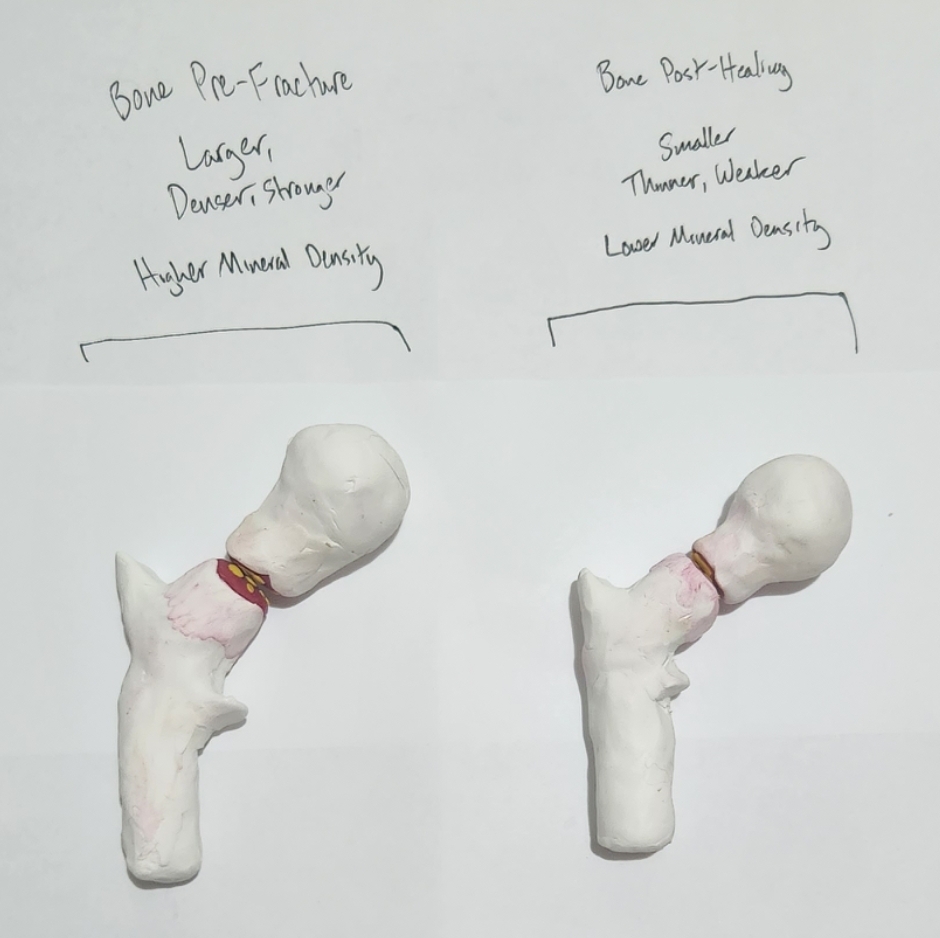

How do fractures affect bone integrity following the initial healing? How long do fractures affect the bone density? Researching these questions has helped me understand bone remodeling and repair more thoroughly. One of the most common types of fractures in geriatric patients is a femoral neck fracture and it is one I deal with frequently as a paramedic (Fischer and Gray, 2020). Geriatric patients are already at high risk of fracture, as most elderly are osteoporitic or have weak bones due to wear and tear or inactivity. A fracture only increases these odds.
Fractures not only take resources from other areas to repair but also reduce bone density during healing due to the patient not using the affected limb or being less active in general (Zheng et al., 2023). Generalized bone density is affected, not just at the site of the fracture. In 60-year-old patients, five years could account for a decrease in the relative risk of fracture by 10-90% (Osipov et al., 2018). The study by Zheng et al.(2023) even showed that fractures following the first one were more likely to be in a different bone due to the generalized lower density of skeletal tissue. The study refers to increased osteoblast and osteoclast activity in two different areas: the RAP or regional acceleratory phenomenon and SAP or systemic acceleratory phenomenon. These phenomena account for the body’s response to the fracture and are used to repair it. This response, while helpful in healing the fracture, tends to increase bone resorption systemically, leading to lower bone density throughout the body (Osipov et al., 2018). This decrease is represented in my project as a thinner femoral neck where the theoretical fracture occurred in the second sculpture. This would be true throughout the body, not just at the site of the fracture as shown in the sculpture.
These acceleratory phenomena are not the only reason for lower bone density and resilience throughout the body. Other examples include immobilization of the limb during healing, lack of exercise during healing, excitement of nociceptive nerves, inflammation, soft tissue injury related to the fracture including blood supply, and sarcopenia. Exercise and physical stress are some of the greatest supporters of bone density and health (Zheng et al., 2023). When the injury occurs, immobilization and rest are some of the most common treatments provided. This not only decreases local bone density due to the lack of activity but also decreases local skeletal muscle density due to the lack of activity. This compounds the effect on bone density, as the lower muscle strength decreases the ability of the muscle to provide the exercise and stress required to promote osteoblast activity (Zheng et al., 2023). This compounds the issue. The majority of hip fractures, especially in older patients require surgical treatment within the first day or so. This treatment allows the pt to get out of bed and continue to use the limb in order to decrease bone density lost throughout the healing process (Fischer and Gray, 2020).
The imbalance between bone formation and resorption decreases over time but can cause a long-term difference. The study by Osipov et al (2018) indicated that there was an increased relative risk of subsequent fracture for decades following a single fracture. Several biochemical pathways are also affected by the lack of activity and inflammation following a fracture Hippo-YAP/TAZ that affects bone transduction based on mechanical load and downregulation following fracture will reduce bone density(Zheng et al., 2023). Piezo1 affects bone density by affecting ion concentrations in chondrocytes (Zheng et al., 2023). Elevated cytokine levels due to fracture including IL-6 will systemically increase osteoclast activity (Osipov et al., 2018). The mechanisms that cause these phenomena are complex and many.
The study by Osipov et al. (2018) also took into account that there may be other factors besides the fracture that caused a decrease in bone mineral density and increased relative fracture risk. The injury could cause permanent damage, resulting in an unsteady gait and an increased likelihood of falls (Osipov et al., 2018). The reduction in strength could also increase the likelihood of falls (Osipov et al., 2018). The increased relative risk of fracture that they measured seems at least partially caused by changes is the functional level of the patient and not simply by changes in microbiology due to the initial fracture. There can be no denying the systemic bone density decrease that even a single fracture can cause.
References
Fischer, S. J., & Gray, J. L. (n.d.). Hip Fractures – OrthoInfo – AAOS. OrthoInfo. Retrieved November 26, 2023, from https://orthoinfo.aaos.org/en/diseases–conditions/hip-fractures/
Osipov, B., Emami, A., & Christiansen, B. (2018, December 6). Systemic Bone Loss After Fracture – PMC. NCBI. Retrieved November 26, 2023, from https://www.ncbi.nlm.nih.gov/pmc/articles/PMC6667184/
Zheng, X.-Q., Huang, J., Lin, J., & Song, C.-L. (2023, June 16). Pathophysiological mechanism of acute bone loss after fracture. Science Direct. Retrieved November 26, 2023, from https://www.sciencedirect.com/science/article/pii/S2090123222002004

I rather enjoyed Josephs project on the long term effects of fractures in bone health. I thought it was rather creative he chose to do a visual of clay, it was easy to be able to decipher the difference and make it that much easier to gain a grasp of. Something about 3D really just helps the information click and that much easier to visualize how that would truly look. What I took away from Josephs project is that layout wise I did take away some tips that I wish I would have done on my own project, such as adding cites after certain facts instead of all at the end. It was interesting to learn that fractures take resources from other areas to repair as well as reduce bone density during the healing stage. This is due to the patient not keeping the limbs mobile and intact. Geriatrics are very susceptible to fractures and it is so important to keep them mobile and moving. It’s also interesting to note that exercise and physical stress are some of the greatest supporters of bone density and health. I like how Joseph was personal in his essay to include that he is a paramedic and sees injuries such as the femoral neck fracture pretty frequently. I like the use of studies to back up his research and the citations were well written.